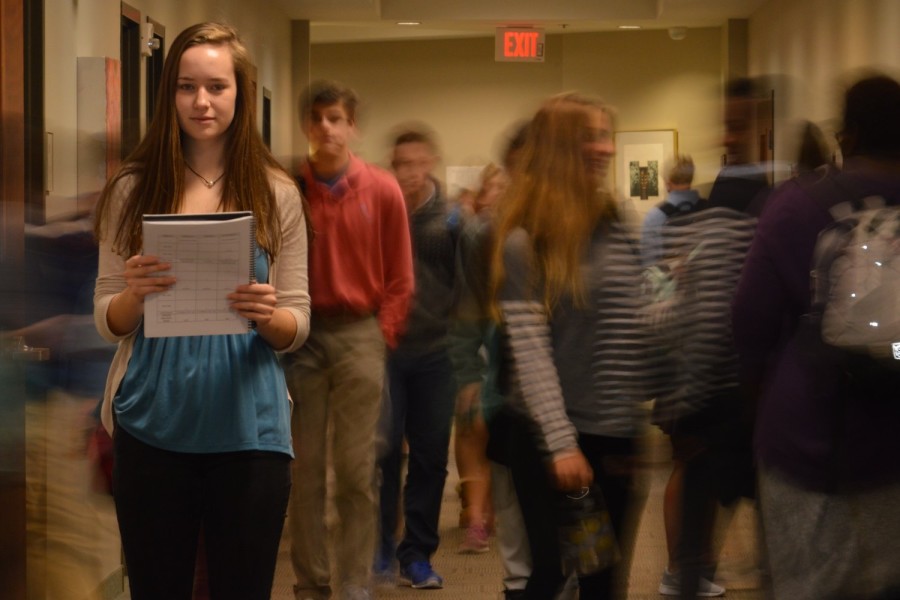Rotating into a new schedule
Proposed changes include late start, semesters
Photo: Katie Boyle
As a part of the new schedule next year, the committee has proposed to get rid of passing periods and bells. If this is incorporated into the new schedule, students would go to their next class immediately after they are dismissed by their teacher.
Imagine school starting at 8:30 a.m., going to four 70-minute classes a day, having an extra letter day and taking exams twice a year. Next year at St. George’s, this may become a reality. These proposed schedule changes were introduced to a small group of students in November. Sophomore Maggie Vento was present at this meeting and is optimistic about the proposed changes.
“I really like it,” Vento said. “I think the fact that we may have semesters and a later start with tutorials in the morning will be better.”
A committee of St. George’s teachers and administrators have been working to create a new schedule for over a year. The committee had two goals in mind when creating the new schedule. They wanted the new schedule to work with both the middle and upper school, and they wanted time to be used more efficiently in both wings, helping students be better rested and focused for class.
“The second piece is grounded in what brain research tells us about how people your age learn,” Head of Upper School Mr. Tom Morris said. “That tells us that the better rested you are with a later start in the day, the better you learn.”
To achieve the first goal, the new schedule would be the same for both middle and upper school, including a seven-period rotation over seven days instead of the current rotation of an eight-period rotation over six days. To accomplish their next goal, the committee proposed a later start time of 8:30 a.m., with tutorials in the morning instead of after school.
Tutorial in the morning will allow sports practices to be held earlier in the afternoon, making it possible for students to start homework earlier than before. Faculty meetings would also be held in the morning on Wednesdays, resulting in a 9 a.m. start time on those days.
“Teenagers need around nine hours of sleep,” Associate Head of School Mr. Will Bladt said. “If we can cut down on the number of homework assignments and get students an extra hour a day, that would be extremely helpful.”
Another significant change in the current schedule includes not having dismissal bells or transitioning time in between classes. Currently, students have a four-minute period to get to class. Next year, however, this four-minute period will be removed and students will get to class as quickly as possible.
Additionally, the new schedule will consist of fewer classes each day, resulting in less homework each night and more time for sleep. However, the reasoning behind fewer classes and longer periods is not solely justified by the need for sleep. Mr. Morris explained that, in general, kids spend 14 minutes transitioning in and out of class, and having 70-minute class periods would add 15 more minutes of engaged, in-class learning.
“The meaningful work you’re doing remains, but the extra work you’re doing declines,” Mr. Morris said. “In essence, what we’re doing is we are trading time outside of school for better and deeper learning in school.”
Teachers will have to adapt to these longer 70-minute periods, as it will be a change from the current 45-minute schedule. The longer class times will require a multifaceted lesson plan with different ways to engage students with the material. In addition, the change in class length will affect what is being and can be taught.
“I think it’s great that it will allow us to go deeper into concepts so we can have students learn material on a deeper level,” upper school math teacher and math department chair Ms. Page McMullen said. “But, the number of concepts that we can cover in a year will have to be reduced in order to compensate for that.”
The committee is also considering making the switch from trimesters to semesters. If this is put into place, students would take exams before Christmas break, and there would still be project exam grades as well as written exams. The hope is that switching to semesters will take out the stress associated with sports seasons ending at the same time as trimester exams.
None of these ideas are set in stone, and there are still many details that need to be worked out. Some of those details includes whether one-third credits will be changed to one-half credits with the switch to semesters as well as when wellness will occur. The actual schedule should be released in January of 2016.
“At our school, we want to use hands-on experiences and project- based learning, and we want to have kids do and make and create and work together,” Mr. Bladt said. “That short class every single day really hamstrings us from designing experiences that are really engaging to kids, and it is something that we need to change.”
http://discover.umn.edu/news/teaching-education/late-start-times-benefit-high-school-students
http://www.socialstudies.org/system/files/publications/se/6002/600202.html















Anne Holmberg • Mar 15, 2016 at 11:25 AM
This article is easy to grasp as it is clearly and cleanly written. St. George’s shows much foresight to base their curriculum changes on brain research and the extensive demands on students.